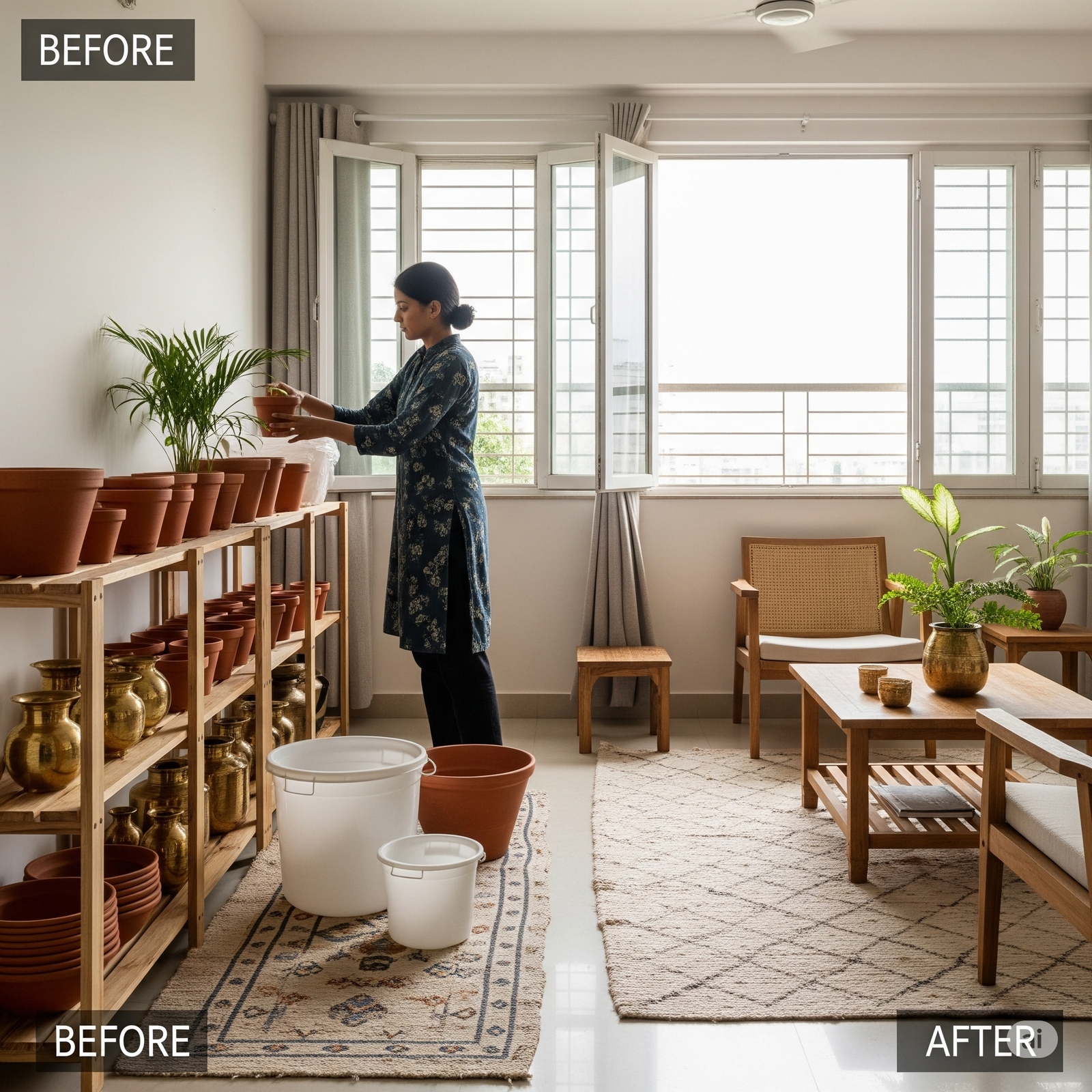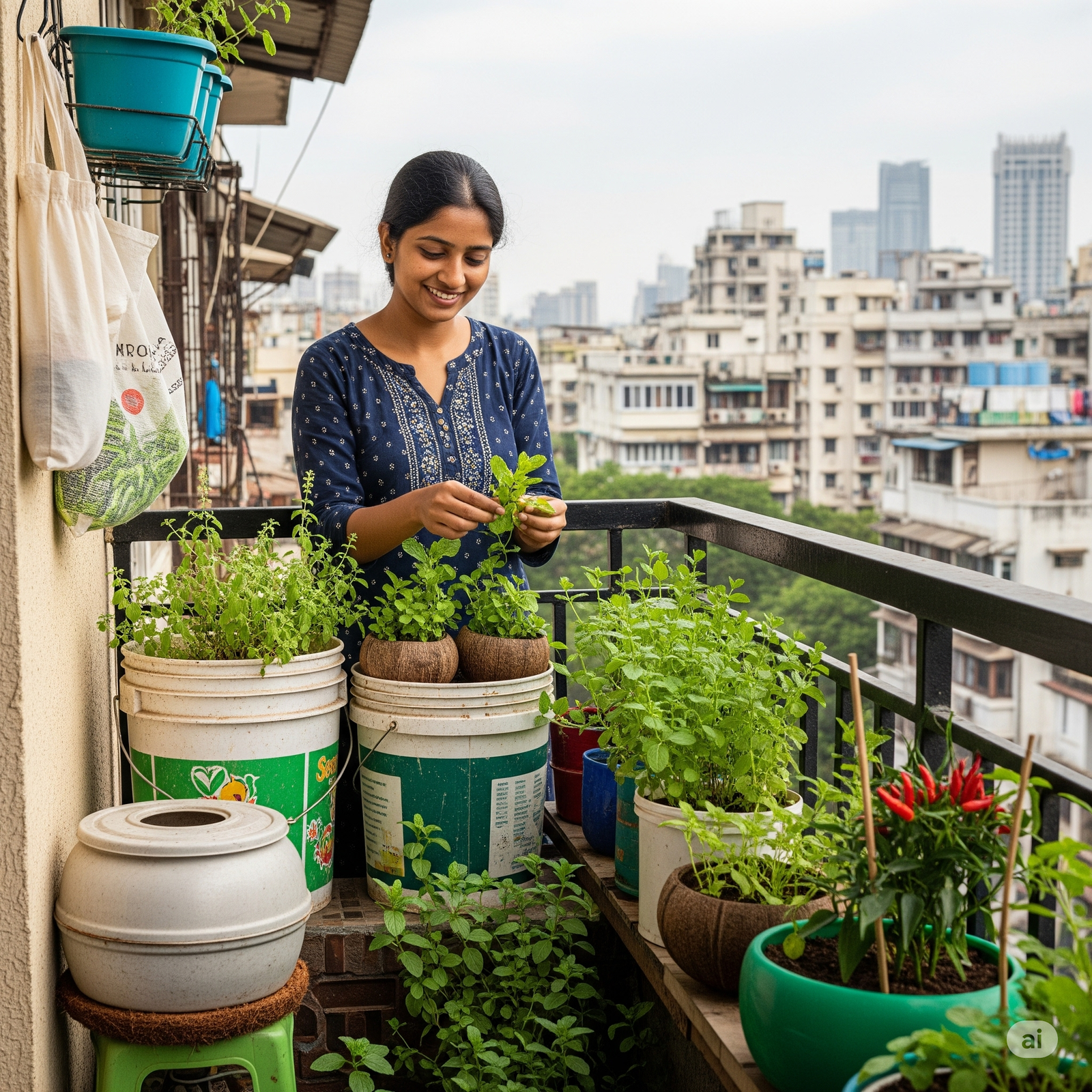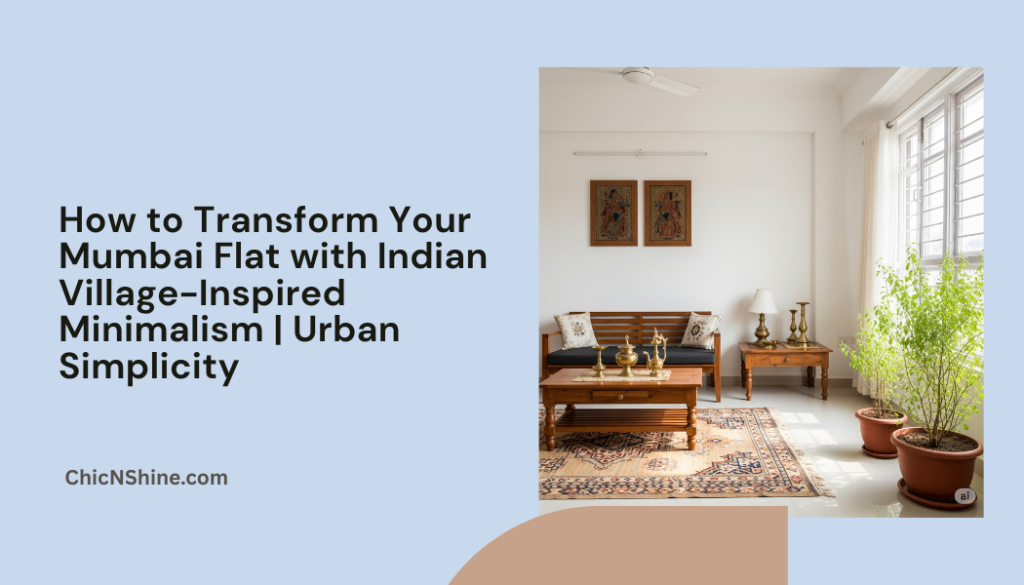Finding Peace Through Village Wisdom in City Chaos
When I moved to Mumbai from my grandmother’s village home in Maharashtra five years ago, the transition felt overwhelming. The constant noise, the cramped spaces, and the never-ending rush made me yearn for the simplicity of village life. Indian village-inspired minimalism became my anchor in this sea of urban chaos.
Today, my 600-square-foot apartment in Andheri feels spacious, peaceful, and connected to my roots. I’ve discovered that bringing village minimalism into city living isn’t about romanticizing poverty or creating a museum-like recreation of rural aesthetics. Instead, it’s about adopting the timeless wisdom of simplicity, functionality, and community that has sustained Indian villages for centuries.
The Philosophy Behind Village-Inspired Minimalism

Before diving into practical applications, it’s important to understand why this approach matters. Traditional Indian villages operated on principles that modern minimalism has only recently embraced:
- Use what you need: Village homes were built and furnished according to necessity, not excess.
- Multi-functionality: Every item serves multiple purposes, reducing waste and clutter.
- Natural materials: Earth, wood, and natural fibers created sustainable, breathable living spaces.
- Community over consumption: Time was spent connecting with people rather than accumulating things.
These principles aren’t just decorative choices—they represent a fundamentally different relationship with our possessions and spaces.
Transforming Your Flat

Declutter with Purpose
My journey began with a radical decluttering process. I wasn’t just removing items; I was questioning their place in my life through a village-inspired lens.
“Does this item serve a real purpose? Would my grandmother have kept this?” These questions helped me reduce my possessions by nearly 60%.
The result wasn’t emptiness, but a newfound spaciousness that allowed for movement, thought, and presence—qualities desperately needed in Mumbai’s compressed living conditions.
Choose Natural Materials
The cool touch of a clay water pot, the textured warmth of a wooden stool—these sensory experiences from village life can transform your urban home. I’ve replaced plastic containers with brass, steel, and terracotta alternatives. My synthetic rugs gave way to cotton dhurries, and plastic furniture was exchanged for secondhand wooden pieces.
When purchasing new items, I recommend looking for sustainable options like the Ellementry Terracotta & Copper Water Dispenser, which brings both functionality and village aesthetics to your space.
Create Multi-Purpose Spaces
Village homes rarely had rooms with a single purpose. Following this wisdom, I’ve designed my flat around activities rather than conventional room divisions:
- My dining area transforms into a workspace during the day
- The living area becomes a meditation space in the morning
- My balcony serves as both a kitchen garden and a relaxation spot
This fluidity has effectively doubled my usable space without changing the floor plan.
Embrace Earthy Colors and Textures
The earthy palette of village homes—terracotta, indigo, mustard, and natural whites—has a grounding effect that counteracts urban stimulation. I’ve painted my walls a soft white and added color through handmade textiles and art.
For my bedroom, I chose Fabindia’s Hand Block-Printed Bedding, which supports traditional artisans while bringing authentic village aesthetics into my space.
Village-Inspired Daily Practices

Morning Rituals
I begin each day with a brass lota of water and a small prayer, just as my grandmother did. This simple practice creates a moment of intention before the day’s demands begin.
The morning light filters through my cotton curtains as I prepare chai in a clay pot rather than a microwave, taking those few extra minutes to be present with the process.
Mindful Cooking and Eating
My kitchen has become a space of connection to village traditions. I’ve replaced most packaged foods with whole grains stored in clay containers, which keep them fresh without refrigeration. A small wooden spice box contains just the essential spices—nothing more.
For healthier cooking, I now use traditional cookware like this Zishta Traditional Iron Kadai, which improves with use and can last generations.
Creating Community
Perhaps the most significant aspect of village life is the community. In my apartment building, I’ve started a monthly “village square” gathering where neighbors share homemade food and skills.
This simple act of opening my home has created connections that defy Mumbai’s reputation for isolation, proving that village values can thrive anywhere.
Sustainable Living Practices

Growing Food
My small balcony now hosts a thriving kitchen garden in upcycled containers. The tulsi, mint, and seasonal vegetables connect me to the agricultural rhythms of village life, even 20 floors above Mumbai’s streets.
To start your urban garden, I recommend the TrustBasket Complete Vegetable Garden Kit, which simplifies the process for beginners.
Reducing Waste
Village life generated minimal waste because everything was used and reused. I’ve applied this principle by:
- Composting kitchen scraps for my plants
- Using cotton cloths instead of paper towels
- Storing leftovers in steel containers instead of plastic wrap
- Repurposing glass jars for storage
These small changes have reduced my weekly waste to just one small bag—a stark contrast to my previous lifestyle.
Balancing Tradition with Modern Needs

Indian village-inspired minimalism isn’t about rejecting modern conveniences. I still use my laptop, enjoy air conditioning during Mumbai’s brutal summers, and appreciate indoor plumbing. The key is intentionality—choosing which modern elements truly enhance life while maintaining village wisdom as a guiding principle.
For instance, I’ve kept my smartphone but removed social media apps, creating technology boundaries that would feel familiar to village elders who understood the importance of limiting distractions.
Challenges and Adaptations
This journey hasn’t been without challenges. Mumbai’s dust means more frequent cleaning of natural materials. Limited space requires creative storage solutions. And sometimes, village traditions must be adapted for apartment regulations.
When my housing society prohibited traditional coal ironing, I found the Philips Heavy Weight Dry Iron, which mimics the weight and feel of traditional irons while meeting building requirements.
The Unexpected Benefits
Beyond the aesthetic improvements to my home, this village-inspired approach has yielded unexpected benefits:

| Benefit | What I Experienced | Why It Matters |
|---|---|---|
| 🌿 Reduced Anxiety | A simplified, clutter-free environment eased my daily stress levels | A calmer space promotes a calmer mind |
| 😴 Better Sleep | Natural materials and fewer electronic devices helped me sleep more deeply | Less blue light and EMF = improved rest and recovery |
| 💰 Financial Savings | Buying less and choosing long-lasting, handmade items cut my monthly expenses | Quality over quantity reduces spending in the long run |
| 🌎 Lower Environmental Impact | My electricity use dropped by around 30% | Less tech and more natural light = lighter carbon footprint |
| ❤️ Deeper Connections | With fewer possessions to manage, I’ve had more time for real relationships | Presence and simplicity create space for meaningful human connection |
FAQs
Won't my home look outdated or poor if I adopt village aesthetics?
Not at all. Today's interpretation of village minimalism is about quality, craftsmanship, and intentionality, not deprivation. My guests often comment on how expensive my home looks, not realizing that most items were chosen for their simplicity and authenticity, not their price tag.
I live with family members who aren't interested in minimalism. How can I still incorporate these ideas?
Start with your personal spaces and shared areas where you have more influence. I began with my bedroom and personal belongings before gradually introducing village-inspired elements to common areas. Often, the comfort and beauty of natural materials win over even the most skeptical family members.
Aren't traditional items more difficult to maintain in a city apartment?
Some natural materials do require different care than synthetic alternatives, but the maintenance is often simpler, not more complicated. Clay pots need occasional soaking, wood needs oiling, and brass needs polishing—but these maintenance rituals themselves become meaningful practices that connect us to tradition.
User Queries from Online Platforms
From my research on Reddit and Quora, here are common questions people ask about bringing village elements into urban homes:
From r/IndianInteriorDesign: “How do I balance modern needs with traditional aesthetics in a small apartment?”
My response: Focus on the principles rather than literal recreations. Choose one focal traditional element (perhaps a wooden day bed or brass collection) and let more modern elements recede visually through neutral colors and minimal design.
From Quora: “What are affordable ways to incorporate Indian village aesthetics without looking like a rural museum?”
My response: Start with relatively inexpensive textiles. Handloom cotton curtains, a dhurrie on the floor, and block-printed cushions can transform a space without major investment.
From r/mumbai: “How do you manage dust and maintenance with natural materials in Mumbai’s pollution?”
My response: Strategic placement helps—keep especially porous materials away from windows. Regular maintenance becomes part of your routine. I dust my wooden surfaces daily with a soft cloth, which takes just minutes but prevents buildup.
Conclusion: A Return to Roots, Not a Rejection of Progress
My journey to embrace Indian village-inspired minimalism in my Mumbai home hasn’t been about turning away from modern life—it’s about reconnecting with the timeless wisdom our grandparents lived by. In my compact flat, nestled within one of the world’s busiest cities, I’ve discovered that the simple, intentional principles of village living offer exactly what urban life often lacks: a calming sense of space, a deeper connection to nature, and liberation from unnecessary clutter.
If you’re feeling overwhelmed by city living, the answer might not be more organizing products or storage solutions. Instead, consider looking back to the villages that form our cultural heritage, where generations lived contentedly with less, but experienced more.
I’d love to hear about your experiences bringing village-inspired minimalism into your urban home. What traditions have you adapted? What challenges have you faced? Share your journey in the comments below.


